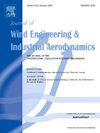对发生涡流诱导振动的 4:1 矩形棱柱进行流固耦合分析
IF 4.9
2区 工程技术
Q1 ENGINEERING, CIVIL
Journal of Wind Engineering and Industrial Aerodynamics
Pub Date : 2024-10-17
DOI:10.1016/j.jweia.2024.105918
引用次数: 0
摘要
本研究基于大涡流模拟,研究了 4:1 矩形棱柱的涡致振动(VIV)特性和流固耦合机理。分析了振动振幅、涡诱力和表面压力随流入速度 (U∗) 的变化。根据流场的动模分解(DMD)和相位分析,提出并解释了有关 VIV 响应的一些重要问题。在 DMD 模式中,确定了运动诱导的前缘漩涡和维持 VIV 的 Karmon 型后缘漩涡的协同脱落过程。研究发现,近尾流中前缘漩涡和后缘漩涡的相位差随 U∗ 的增大而增大,最终导致 VIV 在临界 U∗ 时消失。均方根升力系数(CL_rms)在锁定范围的初始阶段达到最高值,然后随着 U∗ 的增大而单调降低。然而,尽管 CL_rms 可能与静态情况下一样低,结构仍可保持相对较大的振幅,直至 VIV 消失。这种现象的详细解释基于表面压力随 U∗ 增大而变化的相位分布。本文章由计算机程序翻译,如有差异,请以英文原文为准。
Fluid-structure interaction analysis of a 4:1 rectangular prism undergoing vortex-induced vibration
The vortex-induced vibration (VIV) characteristics and fluid-structure interaction mechanism of a 4:1 rectangular prism is investigated in this study based on large-eddy simulations. Variations of the vibration amplitude, vortex-induced force, and surface pressure with the inflow velocity (U∗) are analyzed. Some significant questions regarding the VIV responses are raised and explained based on dynamic mode decomposition (DMD) and phase analyses of the flow fields. The cooperative shedding process of the motion-induced leading-edge vortex and the Karmon-type trailing-edge vortex that sustains the VIV is identified in the DMD mode. It is found that the phase difference between the leading and trailing-edge vortices in the near wake increases with U∗, leading to the eventual disappearance of VIV at a critical U∗. The root-mean-squared lift coefficient (CL_rms) reaches its highest value in the initial phase of lock-in range, and then shows a monotonic reduction with increasing U∗. However, the structure could maintain a relatively large vibration amplitude until VIV disappears, even though the CL_rms may be as low as that for the static case. This phenomenon is explained in detail based on the variations in phase distributions of the surface pressure with increasing U∗.
求助全文
通过发布文献求助,成功后即可免费获取论文全文。
去求助
来源期刊
CiteScore
8.90
自引率
22.90%
发文量
306
审稿时长
4.4 months
期刊介绍:
The objective of the journal is to provide a means for the publication and interchange of information, on an international basis, on all those aspects of wind engineering that are included in the activities of the International Association for Wind Engineering http://www.iawe.org/. These are: social and economic impact of wind effects; wind characteristics and structure, local wind environments, wind loads and structural response, diffusion, pollutant dispersion and matter transport, wind effects on building heat loss and ventilation, wind effects on transport systems, aerodynamic aspects of wind energy generation, and codification of wind effects.
Papers on these subjects describing full-scale measurements, wind-tunnel simulation studies, computational or theoretical methods are published, as well as papers dealing with the development of techniques and apparatus for wind engineering experiments.

 求助内容:
求助内容: 应助结果提醒方式:
应助结果提醒方式:


